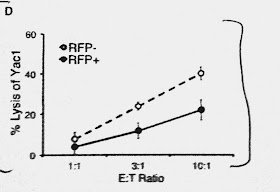Sometimes experimental results are just too unexpected to take at face value.
Take for example a new study from journal Cell about RAG gene and NK cell fitness. This research came from Joseph Sun's lab, a well known expert in NK cell biology.
Almost everyone in immunology knows that RAG genes (RAG1 and RAG2) are involved in TCR and BCR rearrangement. Simply put, RAG1 or RAG2 KO mice lack T and B cells but have everything else. So it seemed that way until now.
This new study focused on NK cell biology. Initially, using RAG fate-mapping mice where any cells expressing RAG gene will be permanently marked with red fluorescence protein, RFP, the authors showed that a substantial proportion of NK cells expressed RAG gene at some point during their development.
Interestingly, direct comparison of NK cells with or without history of RAG gene activity showed that NK cells with no RAG gene activity (RFP- NK cells) have more activated phenotype and are more cytotoxic compared to RFP+ NK cells.
More importantly, an adoptive transfer of equal number of RFP+ and RFP- NK cells into Ly49h-/- recipient, followed by MCMV infection which expands viral antigen specific NK cells, revealed that compared to RFP+ NK cells, RFP- NK cells showed diminished expansion in response to MCMV infection and accelerated contraction so much so that at day 35 post-infection, there were hardly any RFP- NK cells left in recipient mice. Such unusual behavior of RAG KO NK cells were cell-intrinsic since RAG KO NK cells from WT:RAG KO mixed bone marrow chimeric mice or even from natural mutant scid mice showed similar deficiency. Furthermore, NK cells from athymic mice, AID KO, MHC II KO and TCRbeta KO mice showed no such behavior. Even adding back of WT T and B cell to RAG KO mice could not rescue RAG KO NK cells' survival deficiency.
Additional experiments showed that RAG KO NK cells failure to survive had to do with higher rate of cell death (high caspase activity).
Finally, the authors also showed that OVA-specific CD8 OT-I cells on RAG background were also significantly impaired in their survival as compared to WT OT-I cells.
In summary, this study shows that RAG gene expression at some point during the ontogeny of NK cells confers unexpected fitness to NK cells later in their fate. Since RAG gene is not expressed in fully developed NK cells (based on RAG-YFP knock-in reporter mice), this effect of RAG gene on NK cells is quite long-lasting (the authors speculate that this effect of RAG gene has to do with DNA break repair mechanisms).
What about all the studies using RAG KO NK cells or transgenic TCR mice on RAG KO background? Does it mean it we need to re-evaluate those results? Or maybe NK cells with no or RAG gene activity are different NK cell subsets each with special functions? If T cells and B cells have functional subsets, NK cells may have too.
David Usharauli





No comments:
Post a Comment